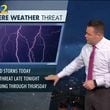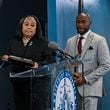A number of Georgia students lack robust internet connectivity in classrooms and their homes, and education officials plan to pour millions of dollars into dealing with the problem, which can hamper learning and put poor students at a disadvantage.
Technology troubles have come to light as a number of metro Atlanta schools reported glitches brought on in part by insufficient bandwidth and other computer-related problems that disrupted the state's Georgia Milestones standardized tests this spring.
As a growing number of schools use the internet more and put laptops, tablets or other technology devices in the hands of children, some school networks are struggling to keep up and need upgrades. Many students who are given these devices also don't have adequate internet access at home, leading to what educators call a "homework gap" that hurts needy students.
Wireless access and internet speed in classrooms remain among the most pressing concerns, and state education officials plan to put millions of federal and state funds into boosting both in the coming years.
So far, nearly $10 billion of federal and private-sector funds have been put toward addressing the connectivity problems across the country.
Georgia has received between $100 and $120 million in federal money in each of the past several years to help provide internet access to schools and expects to get millions more, which it will put toward improving wireless connectivity in classrooms, according to state education officials.
“Where we run into connectivity (problems) is not really at the bandwidth level. It’s more at the classroom level, and that’s wireless connection,” said Bob Swiggum, deputy superintendent for technology services for the Georgia Department of Education. “That’s the one that is probably the fastest-growing and the one where we need the most improvement because that’s what allows the student in the classroom to be able to access the internet.”
It's a problem plaguing school systems across the country as they increase the number of devices used at schools and student homes. Schools are "struggling with the costs of building out the high-performance, reliable networks needed to support the digital transformation envisioned by President Obama's ConnectED initiative," according to Marie Bjerede, with the Washington D.C.-based education advocacy group Consortium for School Networking.
Nearly a third of districts reported that their internet failed for three or more days a year, according to a 2014 survey conducted by the Consortium group. Access for students outside school is also a problem, with close to 80 percent of districts not providing off-campus services.
According to federal data, fewer than 40 percent of schools have the broadband they need to teach using today's technology. The aim of ConnectED is to get 99 percent of students with "access to next-generation broadband" by 2018.
"The White House ConnectED initiative was really around providing that high-speed internet down to the classroom level," Swiggum said. "Just having it in the central office doesn't do any good if the child can't access it."
Milestones testing has come under fire after districts across the state reported computer-related problems. Close to 70 percent of students now take the test online while the rest use paper, though the state wants all students to be taking the test online within the next few years.
Some schools reported bandwidth problems while others were randomly logged out of the state system, losing unsaved work. Some metro districts found incompatibility with the state testing system. State officials reported that 7 percent of test sessions were disrupted, but were not able to say exactly how many students were affected.
State officials have said they plan to work with school administrators and their technology staff to avoid future problems.
Besides connectivity troubles at school, millions of students across the U.S. can't work online at home. Five million households with school-age children do not have high-speed internet service, according to a recent Pew Research Center study. Low-income households – especially black and Hispanic ones – make up a disproportionate share of that.
In DeKalb County, leaders are planning to give students laptops and other devices to use at school and home. With the help of an $8 million grant, the district recently replaced and enhanced its network infrastructure, allowing more use of devices and the internet in the classroom, according to Gary Brantley, chief information officer for DeKalb schools.
To diminish the “homework gap,” the district also plans to survey its families to find out how many need internet connectivity at home. To help those who don’t have it, it’s considering keeping some school buildings open longer for students to do homework and access the internet after regular class hours. DeKalb is also looking at an initiative that would provide Wi-Fi access on buses, so children with longer commutes could do work on the way to and from school.
Forsyth County has given out laptops and other devices for students to use at school or take home in recent years. To help those who don’t have internet access, school officials have allowed them to take home devices so they can do their homework outside the classroom; close to 370 mobile hotspot devices were given out to students last school year, allowing them access the internet at home. The school system has already provided a map of hot spots around the county where students can get online as well.
“We’re trying to cover as many spots as we can to help students,” said Jennifer Caracciolo, a spokeswoman for Forsyth schools.






